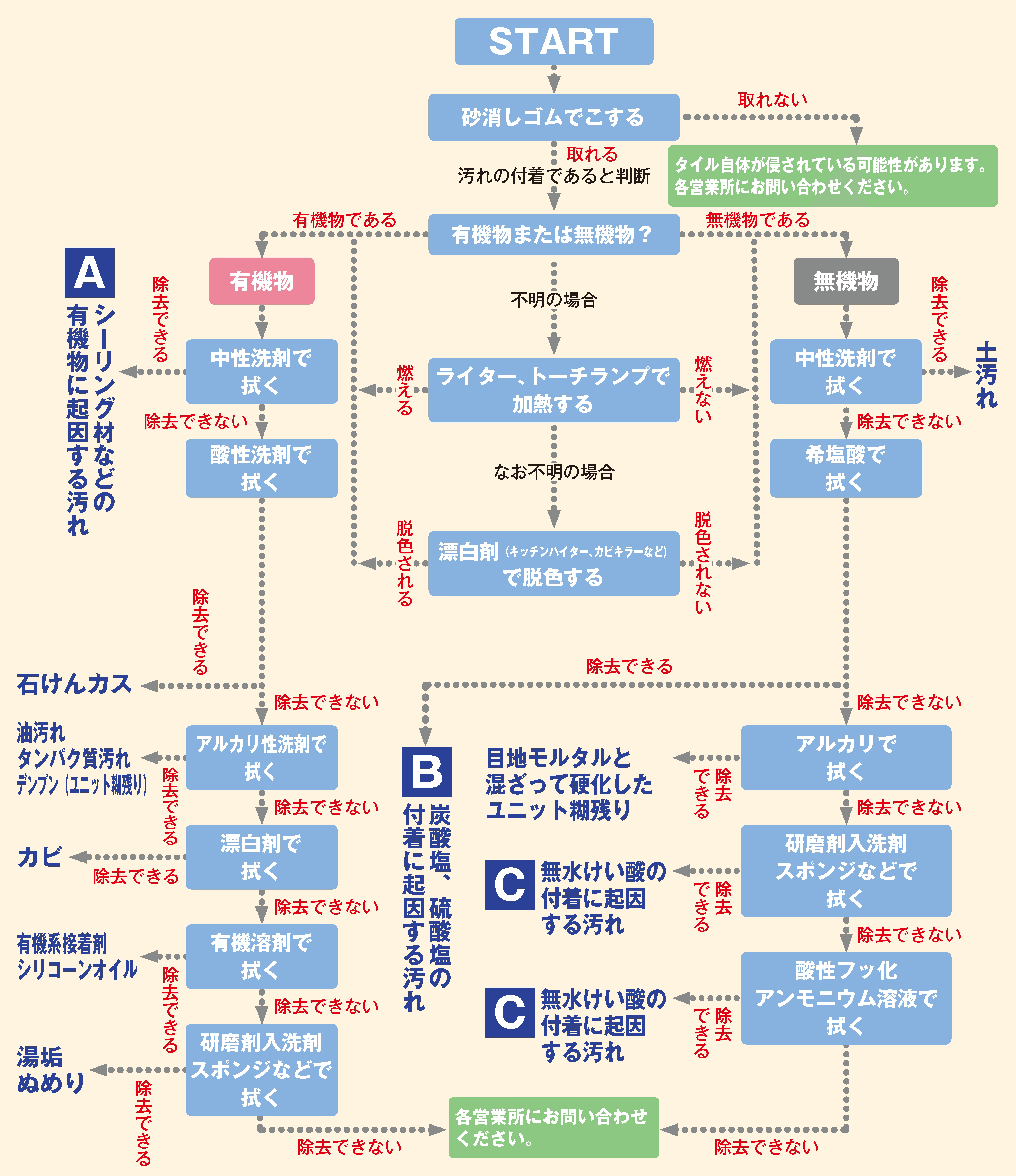- 1
-
Indoor bed
Maintenance method
Use a vacuum cleaner or a broom to remove dirt and dust.
Sprinkle with water and scrub with a scrubbing brush or deck brush.
For hard-to-remove stains, dilute a neutral detergent in water and rub it off with a scrubbing brush or deck brush.Precautions
After cleaning, wipe off the contaminated water. If left untreated, it may cause recontamination.
- 2
-
Bedroom bed
Maintenance method
Remove dust with a vacuum cleaner or a broom, or wipe it clean with a miscellaneous item.
For hard-to-remove stains, scrape off with a sponge moistened with a neutral detergent for housing.
- 3
-
Bathroom Bed・Bathroom Wall
Maintenance method
Sprinkle water on it, scrub it with a brush using a neutral detergent for the bathroom, and then wash it thoroughly.
For dark floor tiles, wipe with a cloth so that no water remains.
If mold adheres to the ground, apply a mold remover, leave it for 5 to 10 minutes, and rub it off with a blue brush.Precautions
Ventilate well when using a mildew remover.
Do not use chlorine-based bleaching agents, mold removers and oxygen-based bleaching agents together. Please read the precautions for using each detergent carefully and use it correctly.
Do not use a sponge with abrasive material.
- 4
-
Kitchen back
Maintenance method
Wipe off oil stains with a cloth dampened with a microwave oven detergent.
Wipe off any dirt that has soaked into the water by tapping it with a cloth dampened with a diluted chlorine-based bleaching agent.Precautions
Ventilate well when using bleaching agents.
Do not use chlorine-based or oxygen-based bleaching agents together. Please read the precautions for using each detergent carefully and use it correctly.
- 5
-
Residential exterior wall
Maintenance method
Scrub with a cloth or a soft brush with water. Then wash thoroughly with water.
For stains that are difficult to remove, use a neutral detergent and clean as described above.Precautions
Do not use hard objects such as scrubbing brushes and brushes.
Do not use thinner, chlorine-based detergent, or other chemicals.
Please note that using a high pressure washer (including household use) may cause damage to the land.
- 6
-
Outdoor bed
Maintenance method
Sweep with a broom.
Sprinkle water on partial dirt and wash it off with a deck brush.
If it is dirty over a wide area, cover it with water and clean it with a polisher equipped with a nylon brush.
For stains that are difficult to remove, use a neutral detergent and clean as described above.Precautions
Wipe off any contaminated water after cleaning. If left untreated, it may cause recontamination.
When cleaning with an electric polisher, do not use pads or brushes with abrasive grains. The tile surface wears and becomes slippery.

Notice
- ● Carefully read the precautions for using each detergent and use it correctly. Also, wear protective equipment (glasses, mask, rubber bag, etc.) if necessary.
- ● Acidic ammonium fluoride is a powerful drug. Please ask a specialist as it requires careful handling.
- ● Do not use dilute hydrochloric acid, oxalic acid, strong acid detergent, chlorine-based detergent or mold remover at the same time. Poisonous gas is emitted.
- ● When using strong acid detergent, dilute hydrochloric acid, or oxalic acid, be careful not to get it on organic products such as water stoppers. There is a risk of rusting. Also, since the water may be damaged, moisten the water thoroughly with water before cleaning to prevent it from being exposed to detergent.
- ● When using an organic solvent, be careful about the water and provide sufficient ventilation.
- ● When using chlorine-based bleaching agents and mold removers, provide sufficient ventilation.
- ● After cleaning, wash thoroughly with water so that no detergent components remain.
- A
-
Dirt in the air and sealing material that has adhered to rain streaks
Dirt in the air, sealing material that has adhered to rain streaks, exhaust fumes, soot and smoke, and other soiling adhere to the wall surface and concentrate in locations in which rainwater flows. The stains remaining in the streaks can be removed only by water washing and wiping. Also use a neutral detergent for stains that contains exhaust fumes and other oil-based components.
Low molecular-weight components in silicone sealing material, such as that around sliding window frames, dissolve and scatter to the surroundings by rainwater and other liquids. The components trap dust in the air to form stains or becomes stains themselves. These stains can be removed by brushing and washing with a neutral detergent, but the stains may return again.
- B
-
Stains from the adhesion of calcium carbonate, etc.
The calcium carbonate is created following the hardening reaction of mortar and concrete. Most is considered efflorescence. Use the product “Actole” to remove efflorescence. For the product “Actole”, inquire at one of our business offices.
- C
-
Stains from the adhesion and solidification of silicon dioxide
Silicon dioxide, carbonate, and sulfate in cement and the air that adhere to a tile surface are transparent, but the interference of light generates an iridescence phenomenon through which an oil film of the colors of the rainbow can be seen. Carbonate and sulfate can be removed through washing with water or dilute hydrochloric acid, but silicon dioxide is often difficult to remove. This type of stain forms on all types of tiles, but it tends to be particularly conspicuous on metallic luster tiles and dark-colored tiles.
